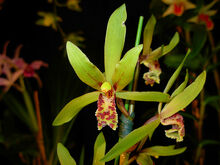| |||||||||||||||||
Cymbidium cyperifolium is a species of Cymbidiumfound in Asia
Description Edit
Edit
Plants blooms from fall to winter with one to five 5 cm wide flowers. Flowers are fragrant.
Distribution Edit
Edit
Plants are found in Nepal, Bhutan, India, Myanmar, Thailand, Cambodia, Vietnam, the Philippines, Guangdong, Hainan, Guangxi, Guizhou, and Yunnan China at elevations of 600 to 1600 meters
Culture Edit
Edit
Grow cool to warm temperatures in diffused light to shade. Use a well drained mix and long pots because of large root system. Plants are grown in various medium such as 100% clay soil, full charcoal; 30% a mix of pumice, 40% clay pellets, and 30% gravel; full lava rock; full medium bark; or 40% perlite, 25% gravel, and 35% bark. Keep area well ventilated. Water once a week and reduce watering during winter.
Varieties Edit
Edit
| Image | Name | Description |
|---|---|---|
 | Cymbidium cyperifolium | green petals and sepals, lip is green and has red spots. |
Naming Edit
Edit
Common Name: The Cyperus-Like Leafed Cymbidium
Distribution in Protected Area(s)/Corridor(s):
| Khangchendzonga Biosphere Reserve |
Plants terrestrial or lithophytic, autotrophic. Pseudobulbs produced biennially or annually, small, 1-3 × ca. 1 cm, enclosed in leaf bases. Leaves usually 9-13(-20), lorate, 30-120 × (0.6-)1-1.3 cm, usually distichous-equitant at base, often with membranous margin 1-3 mm wide toward base, articulate 4-5 cm from base, apex acute. Inflorescence arising from near base of pseudobulb, erect, 20-50 cm; peduncle with several sheaths 2-8.5 cm; rachis 3-7-flowered; floral bracts sublanceolate or linear-lanceolate, 14-41 mm, usually exceeding 1/2 length of ovary. Flowers lemon-scented; pedicel and ovary 12-25 mm; sepals and petals usually yellowish green or apple-green, with 5-7 longitudinal red-brown or purple lines; lip yellowish green to pale yellow, with purple striations on lateral lobes and purple spots or patches on mid-lobe. Sepals linear to linear-lanceolate, 20-37 × 4-8 mm, apex acuminate. Petals narrowly ovate, 16-29 × 5-9 mm, apex acuminate; lip ovate or oblong, 14-22 mm, not fused to basal margins of column, slightly 3-lobed; lateral lobes small; mid-lobe strongly recurved, broadly ovate to ovate-elliptic, 9-13 × 8-12 mm, margin sometimes finely crenulate; disk minutely papillate on lateral lobes and toward apex of mid-lobe, with 2 longitudinal lamellae extending from base of lip to near base of mid-lobe; lamellae slightly incurved toward their apices. Column slightly arcuate, 11-16 mm, narrowly winged; pollinia 4, in 2 pairs.
Forests, rocky places, crevices of rocks; 700-1800 m. Guangdong, S Guangxi, Guizhou, Hainan, Sichuan, Yunnan [Bhutan, Cambodia, India, Myanmar, Nepal, Philippines, Thailand, Vietnam].
CITIES category : Appendix II
References
1.Ref 1
2.Ref 2
3.Ref 3
4.Ref 4

No comments:
Post a Comment